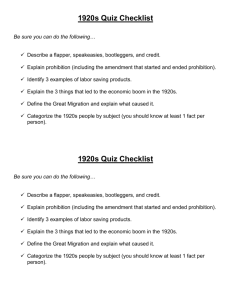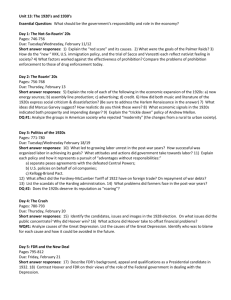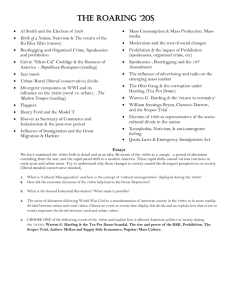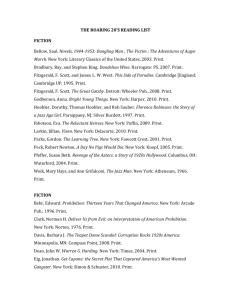Chapters 12-15
advertisement
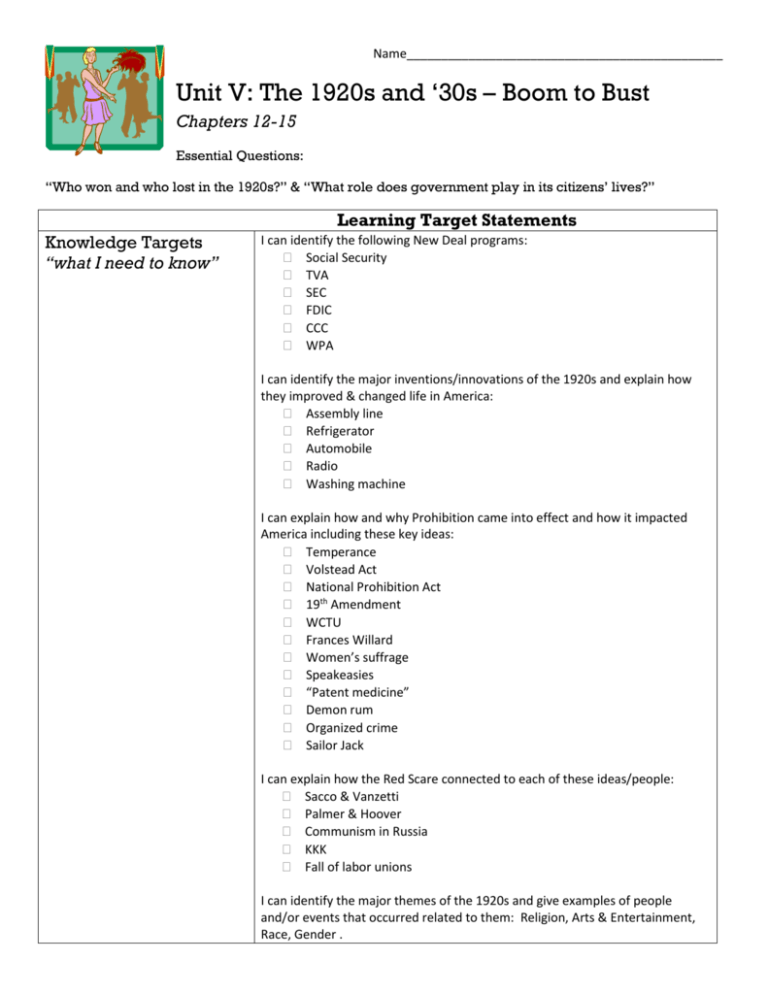
Name______________________________________________ Unit V: The 1920s and ‘30s – Boom to Bust Chapters 12-15 Essential Questions: “Who won and who lost in the 1920s?” & “What role does government play in its citizens’ lives?” Learning Target Statements Knowledge Targets “what I need to know” I can identify the following New Deal programs: Social Security TVA SEC FDIC CCC WPA I can identify the major inventions/innovations of the 1920s and explain how they improved & changed life in America: Assembly line Refrigerator Automobile Radio Washing machine I can explain how and why Prohibition came into effect and how it impacted America including these key ideas: Temperance Volstead Act National Prohibition Act 19th Amendment WCTU Frances Willard Women’s suffrage Speakeasies “Patent medicine” Demon rum Organized crime Sailor Jack I can explain how the Red Scare connected to each of these ideas/people: Sacco & Vanzetti Palmer & Hoover Communism in Russia KKK Fall of labor unions I can identify the major themes of the 1920s and give examples of people and/or events that occurred related to them: Religion, Arts & Entertainment, Race, Gender . I can define the concept of an economic depression and what the “Great Depression” was. I can explain the major causes of the Great Depression and give examples of President Roosevelt’s actions to solve the crisis. Reasoning Targets “What I can do with what I know” Skill Targets “What I can demonstrate” Product Targets “What I can make to show my learning” I can evaluate documents to evaluate the effects of Prohibition on America. I can interpret primary sources to explain how the KKK’s appeal during the 1920s, the nature of its activities, and the objections that Americans held to its existence. I can interpret President Harding’s “Return to Normalcy” speech to determine his goals for America. I can read and interpret a secondary source to use as evidence to evaluate the effects of Prohibition. I can study Harlem Renaissance artwork and poetry and interpret its meaning. I can evaluate primary sources to evaluate the effects of the New Deal on minorities. I can write a one chunk 2+:1 paragraph to argue whether Prohibition was a greater success or failure. I can participate in a 1920s mixer in which I role play a character from the decade. I can solve the mystery of “what happened here” to determine the theme that connects the clues. I can draw a pre-1920s woman and a 1920s woman that illustrates at least five changes that made up the “new woman” I can show my learning of the above concepts through successful completion of a unit test that includes: Multiple choice questions Matching items Primary sources Short answers United States History 2014-2015 “What is an American?” Unit number / corresponding chapter(s)in the Americans Topic & essential question I / chapters 4-5 Reconstruction & the Old West How did the conclusion of the American Civil War change America? Industry and its workers How did the expansion of industry reshape the American landscape? The Progressives What answers did science and government hold for society? America on a World Stage Is it America’s job to exert influence and control in the world? The Roaring ‘20s Who won and who lost in the “roaring” ‘20s? Boom to Bust: The Great Depression What role does government play in its citizens’ lives? II / chapters 6-8 III / chapter 9 IV / chapters 10-11 V / chapters 12-13 VI / chapters 14-15 End of Semester I VII / chapters 16-17 VIII / chapters 18-19 IX / chapters 21, 23 X / chapter 22 XI / chapter 24 XII / chapter 25 XIII / chapter 26 XIV / beyond the text World War II: The Good War What was “good” about this conflict? Cold War and the nuclear age How does the US adjust to life in the nuclear world? Civil Rights What does equality for all citizens look like? Vietnam War Should the United States fight “limited wars” in order to contain communism? Vietnam’s Aftermath How does the Vietnam War change Americans’ relationship with their government? The 1980s: the “me” generation How does the decade of the ‘80s redefine the promise of America? The 1990s: a new world view How does the world landscape change at the close of the Cold War? 9-11 defines the modern world What does it look like to live in the age of “terrorism”?

